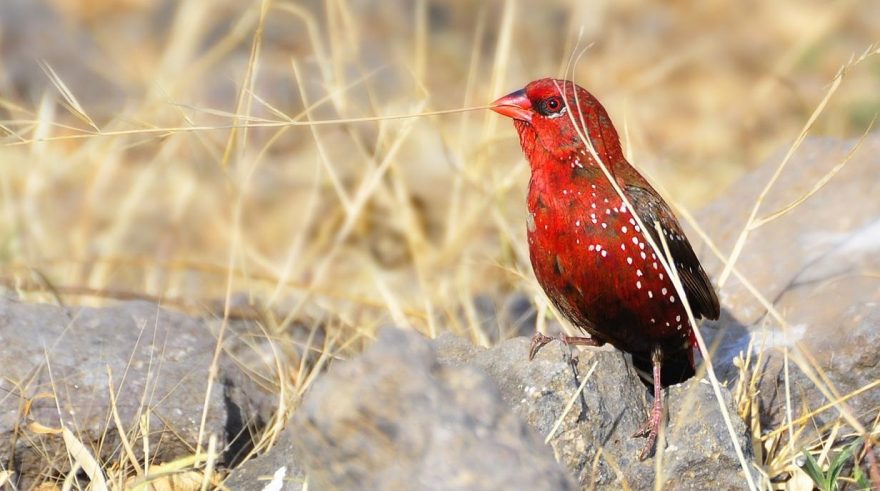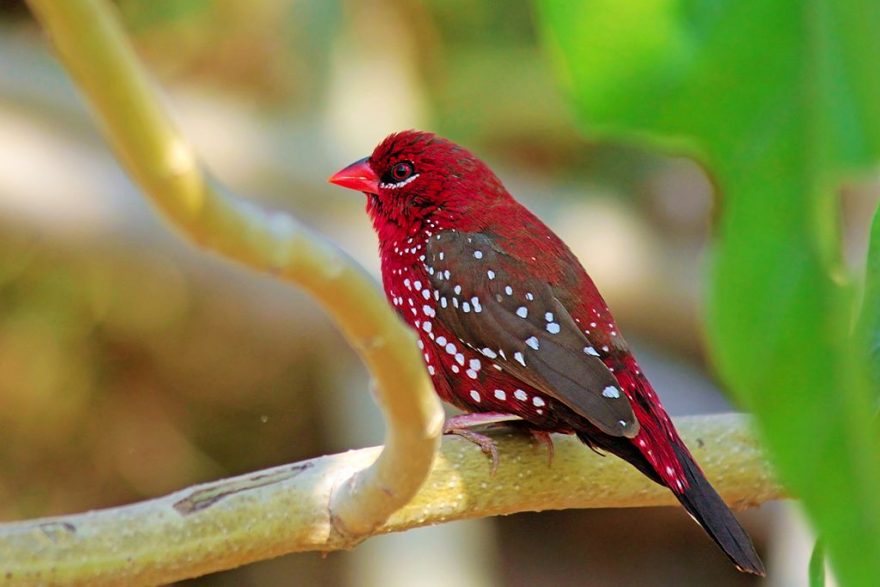The red strawberry finch, known also as the red munia or the red avadavat, is a small finch native to the Indian subcontinent and surrounding south Asian countries. They are considered to be excellent aviary birds but are infrequently kept and sometimes difficult to acquire.

Housing & Compatibility
Red strawberry finches can be housed successfully as single pairs, a colony, or as part of a mixed collection. They prefer a large planted aviary but can be housed in smaller aviaries, however worse breeding results should be expected.
Red strawberry are a placid species and can be housed with most other placid finches. They are a smaller finch species, so care should be taken when selecting aviary mates to avoid species that may be overly assertive towards them. Do not house with green strawberry finches or orange breasted waxbills as hybrids may be produced.
They like to spend a lot of time on the aviary floor, so care should be taken to keep the substrate clean and dry.
Diet & Feeding
A quality seed mix including canary seed, various millets and panicum forms the basis of the Red Strawberry finch’s diet. Seed lacks many essential vitamins and minerals which must be compensated for by introducing other foods. Sprouting seed increases its nutritional value and is a cheap way to improve your birds health. Freshly grown green seed heads should also be offered frequently.
Some leafy green should be provided throughout the year. Kale, bok choy, endive and silverbeet are the most nutritious and will be readily eaten. Spinach can also be given, but only sparingly as it can contribute to calcium deficiency.
Live food is an important component of the Red Strawberry diet and should be provided throughout the year – especially during the breeding season. Mealworms, maggots, termites, and small crickets will be consumed readily. Commercial soft finch food mixes can also be provided for an added nutrient boost, particularly when breeding.
Do not feed anything from the list of forbidden foods.

Breeding
Strawberry finches breed best in spring and autumn, with a hen bird that is at least 12 months of age. Best breeding results are usually achieved in the second year of breeding.
A wide variety of artificial nests will be accepted, though they have a preference for dense brush well above ground level. They will construct a spherical nest from fine strands of dry grass. The nest will often be refurbished and re-used for subsequent clutches, so make sure new nesting material is always available.
They typically lay 3-6 eggs in each clutch, which are incubated by both parents for about two weeks. Nest inspections are generally tolerated, however some pairs may be sensitive to disruptions and abandon the nest, so it’s generally best to avoid inspections if possible.
Young birds fledge the nest at three weeks of age and are usually independent a month later. It’s generally safe to leave them in the same aviary as their parents, but make sure you’re using leg rings to tell them apart as they age.
The Red Strawberry finch will hybridize with the green strawberry finch and the Orange breasted waxbill. As such, they should not be housed together or in adjoining aviaries where contact is possible.
Sexing
Strawberry finches are sexually dimorphic and can easily be sexed. Only males possess the vivid red (nuptial) plumage, and only display it during the breeding season. For the remainder of the year, females and males share the same drab cream coloration albeit with a few additional red patches.
Health
Strawberry finches generally tolerate wet conditions better than other finch species, but the potential spread of disease in such conditions make moisture undesirable. Their tenancy to spend a lot of time at ground level, combined with their diet high in live food, makes them vulnerable to parasite infection. A strict worming and parasite control regime should be implemented to ensure their long-term health.
Healthy birds can be expected to live for approximately 7 to 10 years of age.